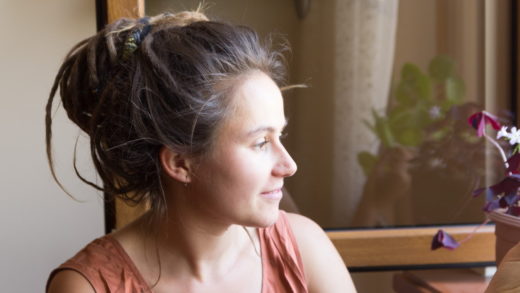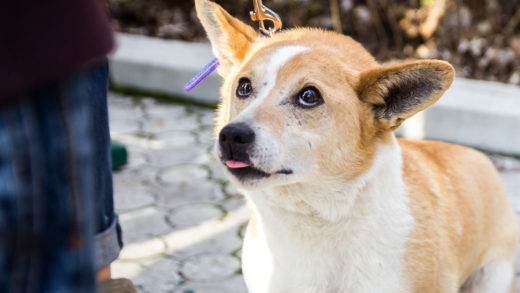When blood doesn’t clot
Author: Hasmik Hovhannisyan
Editor: Fëdor Kornienko
[post_published]
[show_post_categories show=”category” hyperlink=”no” parent=”no”]Bim was killed with rat poison. His murder stays unpunished, as well as hundreds of others in Armenia, where killing a dog is considered to be a mere damage to property.
8 min read
Bim is no more
Noon. Blazing sun. Summer. We let the dogs out, not expecting that anyone would be willing to come outside in such heat. Bim runs out and heads straight to the wire fence; raises a leg and pees, looking ahead thoughtfully. It’s the first thing on his to-do list when he comes out. Then he runs back towards us — shade of a wolf, a deer and a cheetah, as somebody pointed out once — to rub his black-and-white head against our legs, demanding to be caressed and getting exactly what he wanted. How could anyone refuse this fluffy little ball?
9:30 PM. Bim doesn’t eat his portion of dry food. He looks lost and somewhat zoned-out as he walks, as if not understanding where and why. He lifts his leg, trying to pee — but he can’t. Something is terribly wrong: Bim never gets ill, nor does he ever lose his appetite. It was so unusual and scary that we put him in the car and raced over to the vet clinic, scanned and captured by every speed camera along the way.
At 2:00 AM Bim passed away. Autopsy confirmed: death by rat poisoning.

We went home with Bim’s body on the back seat. Did not cry, didn’t talk. Seemed like it happened a long time ago and it wasn’t true, though only an hour had gone by. Seemed like it was some other people who froze next to the ultrasound monitor and watched the hematoma becoming larger with every minute, relentless, unstoppable. It wasn’t us who were suffocating just as Bim did. It was some other people were counting the ampules of “Vicasol” that went into a trash bin, one after another. It wasn’t our two vets who had been barely there, exhausted after the long and tiresome work day. They should have been back home many, many hours before that.
Ampules were opened, used, thrown away, but the blood still refused to start clotting again. The vet’s dog came and we performed a blood transfusion. She tried to slip past us outside, while everyone was busy. Two times Bim’s brain turned off due to extreme hypoxia. On the third time he didn’t come back. Astonishment froze and stayed in his kind, trusting eyes.
Every evening of every day I decided firmly to get up in the morning and tell myself: Bim is no more. And repeat it until I finally understand what happened. And I collapse in pieces, so as to put myself back together again, even though one piece will forever be missing. I try to live it through, to accept it in its entirety. But I can’t do it, not now. It is frightening.
“Will think about it tomorrow,” — my inner voice whispers. Thus, I normally put dry food into his bowl, too, and take it to his kennel. I stop half way through. I gasp for air, push back the tears. Now it isn’t the time for it. If I start, I’m not gonna be able to pull myself together anymore.
I look away from the empty kennel. I need to move some other dog in there.
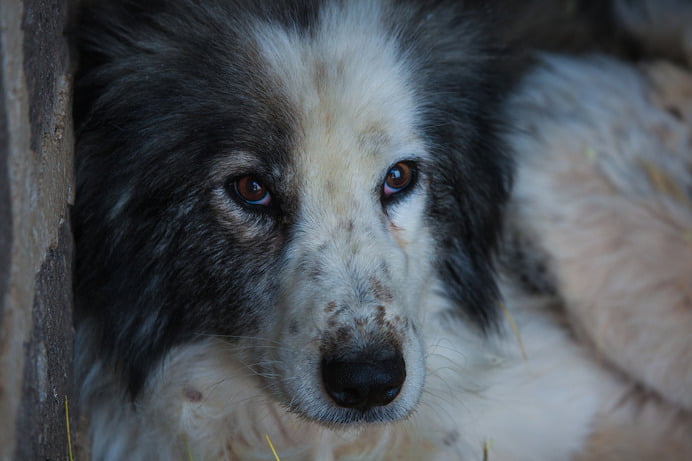
Not long ago I was eagerly telling the many unbelievable stories of how some of our dogs got rescued. Then I paused for a moment. It hit me that that never, ever would anyone hear this again: here’s Bim: he got literally pulled back out from the underworld with the help of a fifty year old cognac.
Bim found himself at our place as a snow-white furry little ball. His owners threw him out because he was dying from CPV, aka canine parvovirus. Our efforts to cure him were fruitless: the puppy was slowly fading away. The vet that had treated our horses before told us to give him cognac. Not any cognac, though — the very best we can find.
There was nothing to lose. My mother had a fifty year old cognac that she had been keeping for at least twenty five years. “For a special case”, she would say. When I brought Bim home, half dead, but inconceivably beautiful at the same time, without a word she put the bottle on the table.
We poured a whole shot into his mouth. The next morning he had already been running like nothing happened. Cured by cognac.

Mysterious case
The day after Bim’s death we went to the police. We sat on hard surfaces of uniform chairs while writing the statement.
— We brought the dog to the vet clinic, but the same night it croaked, — the police officer dictated. I painfully pressed the pen into my palm and lowered my head, if only to not see his bored face. On the first floor there was a crying woman. She shouted that she’d be coming there over and over again, until she’d be accepted.
Other policemen were entering the room, asking questions about arrests and court dates, background noise to our ears. The lethargic, bored inspector had obviously been such a busy man that he was so annoyed at having to waste time on some dog.
But the higher-ups told him to take this case seriously, and he did listen to us, and dictated what we had to put on paper.
In the morning we had a meeting with the deputy chief of the Regional Police Department and the Chief of the City Police. The Deputy said that he had a dog when he was seven and that he still remembered the day of his death and visited his grave. He said that only a bastard could do such a thing — killing a defenseless dog. He said that it was a moral obligation and duty of local authorities to solve the case. Such an approach of police executives gave us hope. But it didn’t make a lot of impact on the ways of ordinary police officers.
— The dog died, — I said.
— The right verb for an animal’s death is… — the inspector started to say in an edifying manner, but he caught my glare. He sighed, — OK, well. Write then: “it died…”
The second hour that we spent with police went by. The inspector literally squeezed questions out of his mind as he tried to make up an interrogation. He struggled to find even the slightest clue and was hoping that maybe, if he did insist very effortfully, that we would agree that it was possible for Bim to have ingested poison somehow with the meat that we feed the dogs with. We tried to keep calm, and for a hundred times explained that our dogs eat only dry food.
After three hours passed the inspector reclined in his chair, lit a cigarette and got lost in thought.
It’s not us, it’s somebody else sitting here in this room decorated as dull and hopelessly as the atmosphere itself in the whole department. Somebody else is speaking about a dog, an abstract dog, too. My mind was protecting itself again.
I went out to the corridor and tried to realize that it was me, that my Bim had been killed. My. Bim. Killed.
A few years ago Bim got used to going to our neighbour’s place and picking fights with their dogs while attempting to get closer to the girl dogs. We had to treat and stitch his wounds endlessly. Once when he tried to sneak out again, pretending that he had suddenly gotten deaf and didn’t hear my commands, I shouted at him. I said that he wasn’t my dog any more, and he was free not to come back ever again.
Bim stayed. It was late evening, I was sitting on a big rock, while he was making circles around the yard. When my anger ceased, I called for him. He looked at me, his face distrustful, and came to me — extremely slowly and sideways, with narrowed eyes. He put his head on my knees. I was patting his soft, black and white head, and I saw large tears dropping out of his eyes. I remembered that I was crying the same way in my childhood, when I made my mother sad…
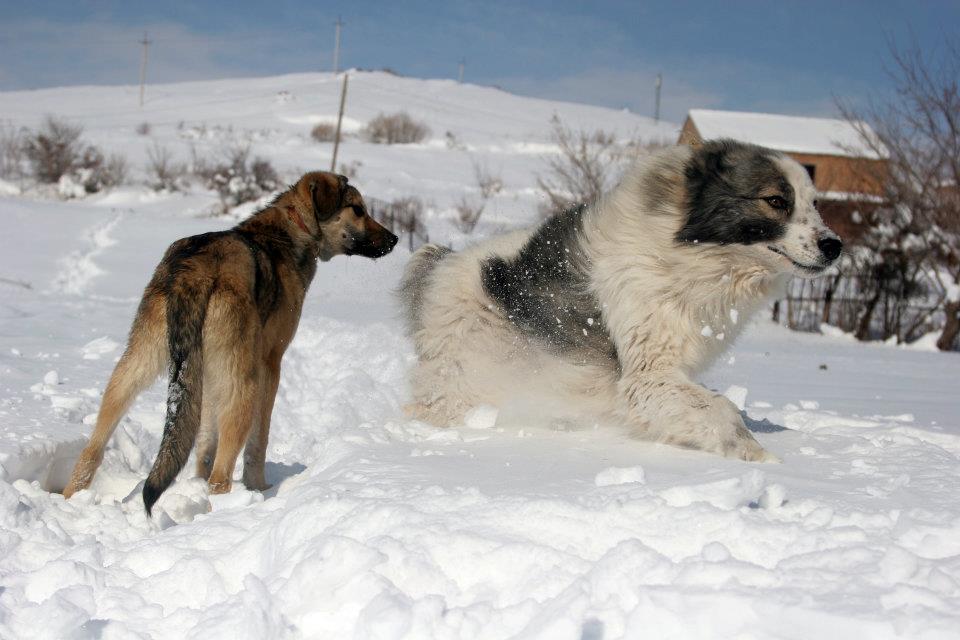
On the following day the inspector came to our village. He stood in the enclosed territory with dog kennels. We closed them beforehand, because the inspector was afraid of them. He asked questions, the same questions we had already replied to before. He asked our volunteer, what was, in his opinion, the reason of Bim’s death. He wrote down: Bim was killed with rat poison.
A few days later the district inspector visited us. He sat on a chair, and kept silent for a while. He looked perplexed. He didn’t seem to notice the sweat streaming from his forehead, and the flies that roamed around it.
— A very mysterious case indeed, — the inspector shook his head. — I don’t understand, who in their right mind could kill the dog. I talked to the people in the village — everyone loves you, and they are proud of having such a center in their village.
Well, if you hate someone, you wouldn’t tell it to a police officer, would you?
— Maybe, there was something in that dog’s food? What do you feed your animals with? — he didn’t stop trying to find another angle. — Maybe, the dog was sick?
Bim was nine and a half years old. Since he survived the virus when he was a pup, he had never been sick ever since. The vet said that his organs were strong and healthy, as if they belonged to a four year old dog. He was poisoned when he was on our enclosed private territory. And the police must find the killer. The inspector asked if we suspected anyone.
I tried to imagine a person, who would throw a piece of meat stuffed with deadly granules in cold blood. I failed.

Outsiders unwelcome
We came to the village with a strange name Ushi (could mean “ears” if it was Russian) ten years ago. We created the center of animal-assisted therapy “Centaur” — the first and still the only one in Armenia. Horses, dogs, cats and a turtle live here together with people. The animals — all of them rescued in the past from streets or cruel owners, — get trained for therapy with children and adults who experience physical and mental disorders.
We also adopt out homeless cats and dogs, sometimes even horses. “Centaur” is a unique and special world, where people and animals learn to interact with and help each other. From all over Armenia children come here: parents bring them, sometimes by recommendation from medical establishments.
But it was not always like that. The idea of using animals in therapy with kids was something we had to thoroughly and persistently push through, among parents and doctors alike. A horse is a dangerous animal, dogs are dirty, and you, the therapist — “you create unsanitary conditions”.
The attitude toward animals is still somewhat exploitative, especially in village life. When we first came to Ushi, on one of the wastelands we discovered a pit. The villagers dumped newborn puppies in there. Only females, because boys tend to find owners quite quickly.
We closed the pit, had a lot of educational talks with locals, even came up with a horrendous “dog curse” that would haunt their descendants for generations lest dogs continue being murdered in the village. That one worked: villagers l-o-v-e curses. Now they secretly leave boxes with newborn puppies under the wall of our stables.
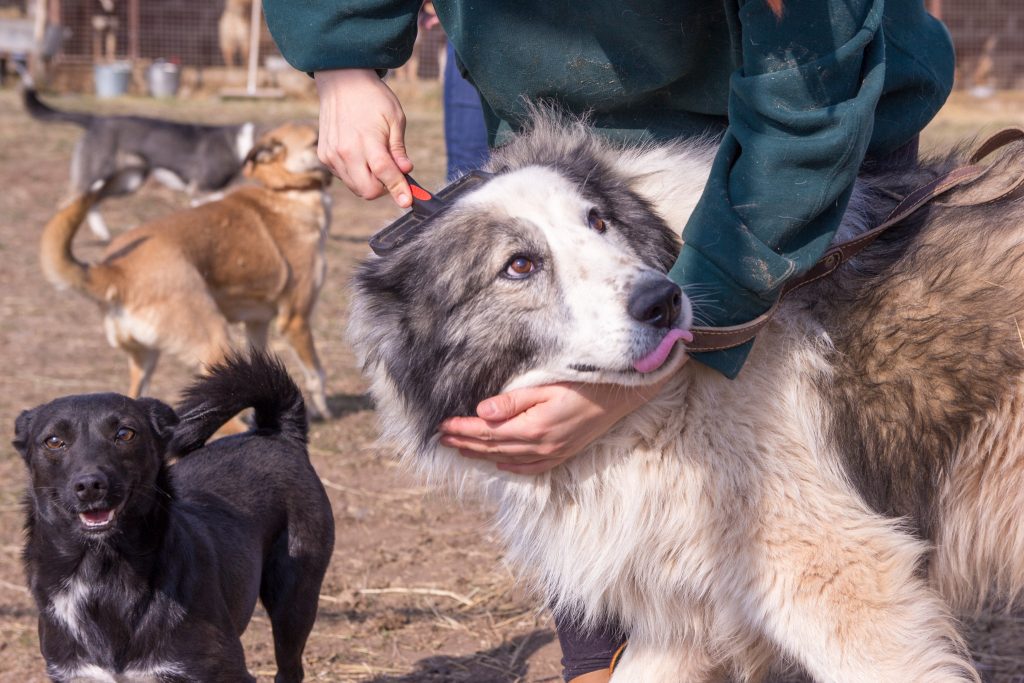
Our relationships with the locals vary. Sometimes, there are “village life” conflicts over a horse that got loose and wandered into their territory, or a dog that barked at somebody, making them scared. Our dogs are well-behaved and friendly, but very much enjoy gathering in packs and running towards people, barking heartrendingly. They run and turn heads back to us, checking to see if we observed their offering of hard work.
Mostly people don’t believe us when we, trying to overcome the dissonant barking, shout at them — they don’t bite! Swinging a stick, they yell back — “A dog is always a dog! Will surely bite sometime.”
When such situations occur, they always remember that we are “outsiders coming from Yerevan” who don’t let them walk around freely and sleep at night. Sometimes they complain about us to the village municipality. But conflicts usually don’t go further than that. There is a reason why we chose such a distant location far away from people: so that humans and animals don’t bother each other.

Two and a half years ago, four Centaur dogs got poisoned with rat poison. Two of them couldn’t be saved.
We went to the police. An inspector came, and for a long time he tried to understand himself why he did come. He assumed that the dogs were purebred and expensive. When we explained that they were ordinary dogs, he suggested that we shouldn’t write a statement about it. If anything really important happened in the future, he said I was to call him on his personal number, “as a sister would call a brother.”
I wasn’t very polite while declining the offer from the caring and “suddenly found relative”, and insisted on police accepting my statement. Police closed the case two weeks after, due to “the absence of corpus delicti (the facts and circumstances constituting a crime).” Nevertheless, the “good guys” from the village resented us for choosing to solve our problem the legal way, and called us “snitches”.
The head of the village expressed his condolences and advised us to build a wall around our territory. He said that the villagers use rat poison to save their trees from rats, and dogs could just accidentally eat it. The thought that somebody could deliberately condemn a dog to such torture was so frightening that maybe we chose to believe it was a coincidence.
One year afterwards our friends from the US helped us gather the money, and with the help of volunteers we built a fence around the dog territory. Bim ate the poison while he was inside the closed territory.
Pink death
Brodifacoum (one of the rat poisons available for sale) is given away to villagers by local municipalities for free. They tell them to not put it next to living quarters and not to store it at home. Villagers put the poison themselves wherever they would like to, not following any rules and without any warning signs.
Appealing for pets and kids alike, pink and blue granules are spread in fields, on city streets under trees, inside public entrances to multi-storey buildings of Yerevan and other cities.
Over the past few decades, rats have grown immune to what is commonly called “first generation of rat poisons”. The task of the second generation, which includes much more potent and lethal poisons (brodifacoum being one of them), is to not kill rats immediately, but to affect the blood’s ability to coagulate. The first symptoms of poisoning can manifest a few days after initial ingestion. As such, there is no way for rats to connect the death of their kin with the food they ate.
Symptoms don’t show up immediately with dogs, too, and dogs are in fact the most sensitive animals towards the poison.
If a dog ate a few granulas, you probably won’t know about it until the very end. When it is already too late.
Rat poison gets more effective every year, but the rat population doesn’t decrease. Yerevan (and generally Armenia with its vast deposit of trash), is the ideal place for a carefree life of rodents.
The situation could have had room for improvement with the help of cats, but the Armenians traditionally don’t like them. In Ushi a lot of people put the deadly pink granules in their own cow sheds, and sometimes the cattle pick it up and die a terrible death — but almost nobody owns a cat.

Unaffordable antidote
One and a half years ago I stumbled upon a Russian online forum where people discussed the only antidote for rat poison — Vitamin K, aka konakion, aka fitomenadion. Brodifacoum gets in the way of the body’s ability to produce the vitamin K — the vitamin responsible for the process of coagulation of blood. The poison causes strong internal bleeding, from which an animal slowly dies.
Konakion is produced for animals and humans alike. The patrons of that forum were talking about how expensive the drug was for people and how next to impossible it was to get for animals. Back then I called all the major Armenian pharmacological networks. There was no Vitamin K.
Why didn’t we stock up on konakion that could possibly save Bim’s life? Why didn’t we order it from France, where it is produced? Why didn’t we educate other pet owners about the danger?
It is very likely that we went through a period of giving up. One of the dogs that died in the first “wave” was Mumu. Mumu wasn’t a dog: he was our stronghold. He appeared in Ushi before us, and lived in Centaur for eight years — a lot of people said that he had been our symbol. There are people and animals who are — it seems — everlasting. And when they go, you lose the ground under your feet.
Then you immerse yourself in the everyday life of an animal shelter with more than forty permanent residents and all of a sudden dozens of other animals get rescued, treated, rehabilitated, trained and adopted. Some of them need to be seized literally from the hands of death — in the middle of the night, of course, and far away from where we live. Others run out of dry food or hay — we have to find money. Other ones need pills, injections and serums, usually costing more than we can afford.
Konakion had been lost in this Brownian motion.

After Bim we started to call pharmacies to ask if they had any vitamin K in stock.
— No, and we’ve never had it.
— You mean vitamin B?
— You sure it exists?
During one of the calls we had a hunch that we should change the query — and we asked about konakion. “Wait a second, I’ll look it up. Yes, we have it, but only one pack.”
Konakion can save a life, human or animal, in case they’ve been poisoned with any of anticoagulant-based poisons.
When in a fever, when a loved one is dying on a cold clinic table, a lot of people might not remember all other names for the only antidote.
Having called the other pharmacies, we found out one or two more packs. Not enough. A few months later we tried to save someone else’s dog from poisoning and called the pharmacies again, but there was no konakion in stock.
Not every vet knows that konakion exists in Armenia, too. Only one of the specialists we spoke with knew and used the medicine in his practice.
Meanwhile, the availability of konakion doesn’t mean every pet will be saved, simply because it’s pricey. A sick animal may need it regularly for up to one month after the start of treatment, depending on the severity of poisoning. At a minimum, one pack is priced at 6,500 dram (~14 USD). The price for konakion on its own may cost around 30,000 dram (~60 USD) per day, depending on the dog’s weight. With the average Armenian salary being equal to or less than 300 USD, pet owners will likely just not be able to afford this.
Rat poison is given away for free.
Two hundred dollars
A few days after the police started investigating the case, we got a visit from an investigator. Young, cheerful and energetic. He was twisting a pen in his hands and apologized all the time, but protocol must be followed. He understood that the dog was priceless to us, but… in Armenia a dog is considered to be private property, and killing one equals to damaging someone’s property. And it is only subject to an administrative fine.
In other words, how would I estimate the dog’s cost?
A child’s mother had died. He became reserved in his terror of not understanding what had happened: he neither cried, nor talked about her. Relatives brought him for horse-therapy only because they had tried everything else.
The boy would sit on the horse, climb of it when the session was over and go back to the car, always expressionless. “I wish he would show a single emotion. Any” — his grandmother was sobbing.
Once he got down from the horse and went to the car, as usual. Bimok had just been coming back from his favourite pastime: walking alone in the fields. He ran to the boy and, with little thought, flopped his head down to the boy’s feet — to get caressed. For Bim all the hands in the world existed with the sole purpose of caressing him.
The boy stopped, caught off his guard, and started to move his hand along with the fur on Bim’s head. Bim cuddled to him even closer. Suddenly the child got down on his knees, embraced Bim and — started to cry. Out loud, without control. Tears mixed up with nasal discharge fell on Bim’s muzzle. The wolfie squinted as the two cuddled tighter…
— What was his breed? — the investigator was hiding his eyes from mine.
— Caucasian shepherd.
— Two hundred dollars. Can we write two hundred dollars? — he was almost begging.
In less than one month our energetic investigator languished. He failed to find a suspect, nor even signs of a premeditated murder. When he claimed that he interrogated a lot of people, I asked: did he encounter any dog owners, whose pets died because of rat poison, too? The detective hadn’t found any connection here, as well.
Meanwhile, there are plenty of other dogs in the village that are not ours. If it was in fact the case that Centaur dogs consumed rat poison just by mere coincidence, then one would expect that there would be other, similar cases. Following the logic, we conducted our own investigation. And we didn’t find any case that matched. Turned out that only our dogs were prone to accidentally picking up the poison.

We found the dogs that were killed by rat poison in Yerevan. The animals ate the pellets which were disbursed in residential buildings, on streets and lanes, and they were baited by neighbours. Most of the owners knew who had killed their pets personally, but they didn’t go to police. When we suggested them to do so, they refused, as expected. The people are sure that the police are powerless, because there is no law protecting animal rights in Armenia. And they are right — there is none.
The other, even stronger reason not to call the police is the concern of being considered a “snitch”. The so-called labour camp culture, which is closely integrated into Armenian everyday life, dictates firmly: break our enemy’s legs, but police is a no-go.
The fight
We took 2 liters from Bim’s abdomen and tried to find a lab where it would be possible to perform a blood examination for the signs of rat poisoning. We didn’t know at the time that a specific deficiency of vitamin K-dependent blood coagulation protein must be observed in the blood sample. It didn’t matter, though: none of the labs in Yerevan had the necessary experience to do that. The word “brodifacoum” was something the forensic scientists learned from us for the first time.
On the first day in the police headquarters they promised to find the right lab as soon as possible, and advised us to keep the blood frozen. The inspector reassured us that when the time came they would take both the blood and the plastic packaging from the pork sausages we gave them (we had found them in the dog yard where Bim was poisoned), and that it was unnecessary for the police to come and inspect.
The time had come eleven days later. The investigator looked at the bottle with blood and stated ruefully that blood had probably already become unsuitable for testing. “Who in their right mind would keep blood in a freezer?” — he said with a condescending smile.
The results of the blood expertise came from the lab after a month, of plastic packaging — in one and a half. As expected, they couldn’t find anything. Ashtarak police closed the case, making a meaningless promise to reopen the case if any evidence would ever be found.

But the fight goes on. The fight through the pain, through the dreary thought that Bim is no longer here, and will never be, and that his murderer shall never be punished. The fight for implementing the law on animal rights that will not treat animals as a private property, and which will allow criminal prosecution of those who violate it. The fight to prohibit the free distribution and unregulated usage of rat poison. The fight to change society’s criminal mentality that tells people who share it that beating up is the only right way to solve conflicts, and that doing things the legal way means becoming a snitch.
This fight is hard, but not fulfilling. People can change, laws and governments can change, too, but whatever the outcome of fight is going to be, we have to live our lives knowing that none of these struggles will ever bring Bim back.
Become a Patron
We are building a community of affectionate, non-judgemental people with an open mind. If you want to support our work of investigating the deepest social issues through personal stories of real people, the best way is to join us and become a Patron.
Text is over, story goes on
Here on Kalemon, we bring unspoken social issues to life in the form of narrative stories. Our mission is to create social impact by breaking taboos and freely discussing important matters, such as violence, poverty, discrimination, parental and medical ethics, and so on.
Kalemon is a non-profit online media that exists thanks to the financial support of individual people. Small, but regular donations from our readers help us write articles, train & recruit new authors, maintain and develop the website.
As little as 2 dollars per month can make a difference. Thank you!



